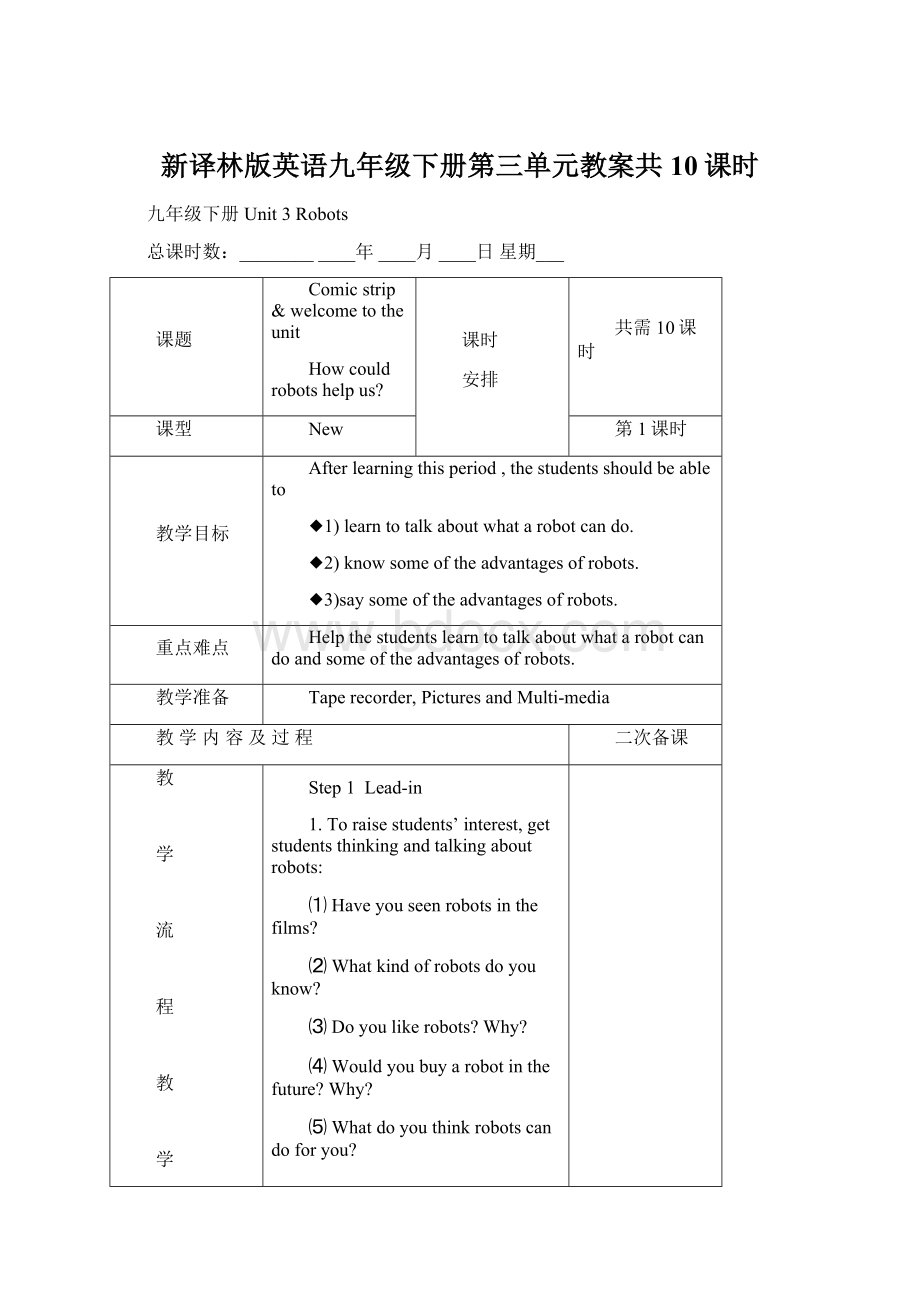新译林版英语九年级下册第三单元教案共10课时.docx
《新译林版英语九年级下册第三单元教案共10课时.docx》由会员分享,可在线阅读,更多相关《新译林版英语九年级下册第三单元教案共10课时.docx(25页珍藏版)》请在冰豆网上搜索。

新译林版英语九年级下册第三单元教案共10课时
九年级下册Unit3Robots
总课时数:
____________年____月____日星期___
课题
Comicstrip&welcometotheunit
Howcouldrobotshelpus?
课时
安排
共需10课时
课型
New
第1课时
教学目标
Afterlearningthisperiod,thestudentsshouldbeableto
◆1)learntotalkaboutwhatarobotcando.
◆2)knowsomeoftheadvantagesofrobots.
◆3)saysomeoftheadvantagesofrobots.
重点难点
Helpthestudentslearntotalkaboutwhatarobotcandoandsomeoftheadvantagesofrobots.
教学准备
Taperecorder,PicturesandMulti-media
教学内容及过程
二次备课
教
学
流
程
教
学
流
程
教
学
流
程
Step1Lead-in
1.Toraisestudents’interest,getstudentsthinkingandtalkingaboutrobots:
⑴Haveyouseenrobotsinthefilms?
⑵Whatkindofrobotsdoyouknow?
⑶Doyoulikerobots?
Why?
⑷Wouldyoubuyarobotinthefuture?
Why?
⑸Whatdoyouthinkrobotscandoforyou?
Asksomestudentstoshowtheiranswers.Encouragetheopenexpressionsofideas.
2.Dividetheclassintogroupsoffourtodiscusswhatarobotcandoandwhatarobotcandoforstudents.Usethequestionsaboveasahelp.
Step2Presentation
1.UsetheMulti-mediatoshowmanypicturesofrobotstothestudents.Letthestudentsknowthatarobotcandoalotofthingsforhumans.
2.Teachsomephrasestothestudents(thephrasescanshowwhatarobotcando).
cookinner,dothelaundry,exploredangerousplaces,ironshirts,knoweverything,lookafterchildren,makethebed,remembereverythingwell,sweepthefloor,washthedishes.
3.Getthestudentstodosomereadingaboutthephrases,Makesurethatallstudentsunderstandthemeaningsofthephrasesintheirownwords.
Step3Readingandpractice
1.Theteacherexplainsthecontext:
“DanielisexplainingtoAmywhatarobotcando”.
2.Askstudentstocompletetheconversationonpage23ontheirown.
3.Asktwostudentstoreadtheconversationandcheckmistakes.
4.Askthestudentstopractisereadingthedialogueinpairs.
Step4Discussion
Encouragestudentstotalkaboutifrobotsareharmful?
Dividestudentsintogroupstodiscuss.
①Whatdorobotsdoharmtohumanbeings?
②Whydotheydoharmtohumanbeings?
Step5Listenandread
TellthestudentsthatEddiehasarobot:
“WhatdoesEddiethinkofhim?
”ListentoadialoguebetweenEddieandHoboandanswerthefollowingquestions:
1.IsEddiesatisfiedwithHobo?
2.Whatishedoingnow?
3.WhenwillHoboposttheletterforEddie?
Listentothetapeforthesecondtimetoreadafterthetape.
Asksomestudentstoactoutthecomicstrip.
Step6Explaining
1.complaint:
不可数名词“抱怨”;可数名词“抱怨的行动或话,投诉”。
complain:
动词:
complaintosb.aboutsth.,complaintthat
2.post:
动词“邮寄”:
postsomethingforsb.
3.Idon’twanttohearwhatyouhavetosay!
4.Idon’tknowwhenI’llposttheletterforyou.
Step7Oralpractice
1.Readthepassages1and2.
2.Recitethetopic1.
Step8Homework
1.Recitetheusefulvocabularyandcomicstrip.
2.Completesomeexercises.
3.PreviewReading.
板书
设计
教后记
九年级下册Unit3Robots
总课时数:
____________年____月____日星期___
课题
ReadingA:
Livingwitharobot
课时
安排
共需10课时
课型
New
第2课时
教学目标
Afterlearningthisperiod,thestudentsshouldbeableto
◆1)understandtheideaofhowrobotscanchangeourlives.
◆2)recognizeandunderstandvocabularyaboutlifewithrobots.
◆3)identifythegoodpointsofowningarobot.
重点难点
Helpthestudentstorecognizeandunderstandvocabularyaboutlifewithrobots.
教学准备
Taperecorder,PicturesandMulti-media
教学内容及过程
二次备课
教
学
流
程
教
学
流
程
教
学
流
程
Step1Revision
1.CheckthehomeworkofPeriod1.
2.Askandanswersomequestions.
1)Whatcanarobotdoforhumans?
2)Ifyouhavearobot,whatdoyouwanthimtodoforyou?
3)…
Step2Presentation
1.UsetheMulti-Mediatoshowthethingsarobotcandotothestudents.Reviewthethingsthatarobotcandoin“Welcometotheunit”.
2.TellthestudentsthatMrJiangisthefirstpersontoownarobotinSunshineTown.Getthestudentstolistentothetapeandthenfindtheanswerstothequestions:
a.CantherobotdoalotofthingsforMr.Jiang?
Givetwoexamples.
b.Doallthingsgowell?
Whathappenedatlast?
c.WhatdidMrJiangdecidetodowiththerobot?
Step3Reading
1.Getthestudentstoreadthenewwords.
2.Tellthestudentstodoafastreading,andthentrytodividethepassageintofourparts.
Part1:
IntroducethefirstpersontoownarobotinSunshineTown.
Part2:
Goodchanges.
Part3:
Badchanges.
Part4:
Ending.
3.Encouragethestudentstodointensivereadingandthenfinishtheprofileabout“Therobotathome”.(showitonthescreen)
Name:
Mr.Jiang
Work:
Salesman
Where:
(live)
InMoonlightTown
Why:
(buyarobot)
Inordertohavemoresparetime
Where:
(buyarobot)
Fromarobotshop
How:
(dealwiththerobot)
Returntherobottotherobotshop
Step4Discussion
Askthestudentstodiscussiftheyhavearobot,whatgoodpointswilltheyhave?
Thenwhataboutbadpoints?
ThenaskthestudentstofinishPartB2.
Step5Listenandread
Playthetapeforthestudentsandgetthestudentsreadafterit.Askstudentstoreadeachparagraphandputforwardquestionsiftheyhave.
Step6Oralpractice
1.Readthepassages3and4.
2.Recitethetopic2.
Step7Homework
1.Remembertheimportantphrasesandsentences.
2.Trytofinishsomerelativeexercises
板书
设计
教后记
九年级下册Unit3Robots
总课时数:
____________年____月____日星期____
课题
ReadingB:
Buyingarobot
课时
安排
共需10课时
课型
New
第3课时
教学目标
Afterlearningthisperiod,thestudentsshouldbeableto
◆1)understandtheideaofhowrobotscanchangeourlives.
◆2)recognizeandunderstandvocabularyaboutlifewithrobots.
◆3)graspthenewwordsandexpressionsinthispartandimprovetheirreadingability.
重点难点
Helpthestudentstounderstandtheideaofhowrobotscanchangeourlives.
教学准备
Taperecorder,PicturesandMulti-media
教学内容及过程
二次备课
教
学
流
程
教
学
流
程
教
学
流
程
教
学
流
程
Step1Revision
1.CheckthehomeworkofPeriod2.
2.Askandanswersomequestions.
1)Whatcanarobotdoforhumans?
2)Ifyouhavearobot,whatdoyouwanthimtodoforyou?
3)…
Step2Languagepoints
1.Explainsomethingimportanttothestudents:
someusefulexpressionsandsentences.
2.Paymoreattentiontothefollowingones:
⑴Inordertohavemoresparetime,Ineedtobuyarobot.
为了有更多的空余时间,我需要买一个机器人。
inordertodo…意思为“为了……”,表示一种明确的目的。
e.g.Inordertocatchtheearlybus,Igotupat5:
30inthemorning.
为了赶早班车,我早上五点半就起床了。
inorderto还可以放在句中,如上句还可以说成:
Igotupat5:
30inthemorninginordertocatchtheearlybus.
⑵Asaresult,MrJiangnolongerneededtogetupearlytodothehousework.
结果是江先生不再需要起早做家务了。
asaresult意思是“结果是……”,表示事情的结果,一般放在句首。
e.g.Mybrotherdoesn’tworkhardatschool.Asaresult,heoftenfailsinhisexams.
我弟弟在学校不用功,结果是他经常考试不及格。
⑶MrJiangwasveryhappywithhisrobot.
江先生对他的机器人很满意。
这里behappywith不表示“高兴”,而是表示“对……满意”,类似于besatisfiedwith。
e.g.Areyouhappy/satisfiedwithyourjobnow?
你对现在的工作还满意吗?
⑷Afewweekslater,however,thingsstartedtogowrong.
然而几周后,情况开始有些不对了。
gowrong在这里表示“出现问题”。
e.g.Thingsstartedtogowrongwhentheymovedtothecitycenter.
当他们搬到市中心去后,问题出现了。
gowrong用于机器时,可以表示“不工作了,出故障了”。
e.g.Somethinghasgonewrongwiththeclock.这只钟出毛病了。
⑸WhenMrJianggothome,hewouldfindcoinswerespreadalloverthefloor.
当江先生回到家,他发现硬币撒得一地都是。
spread在这里意思是“使分散,使分布”。
e.g.Seedsareoftenspreadbythewind.
种子通常是随风传播的。
请注意:
动词spread的过去式和过去分词和它的原形是一样的,即spread-spread-spread。
Step3Retellingandexercises
1.Trytoretellthepassageaccordingtothekeywords.
2.FinishPartB1andPartC.
3.Additionalexercises:
完成句子
1.因特网已经在很多方面改变了我们的生活。
TheInternet___________________ourlife___________________________.
2.为了能挽救那个病人的生命,医生们已经试用了所有有效的药物。
________________________savethe_________________,doctors_______________alltheeffectivemedicines.
3.新规定使这座城市的交通状况产生了很大的改观。
Thenewrule________a___________________________thecity’strafficconditions.
4.他改变了饮食习惯并且每天锻炼,结果很快便减肥成功了。
He________hisdietand________everyday._______________________,hesuccessfully________his________.
5.我的电脑上周感染了一个病毒,它开始工作不正常了。
Mycomputer________________________lastweekanditstartedto_____________.
Step4Oralpractice
1.Readthepassages5and6.
2.Recitethetopic3.
Step5Homework
1.Recitethenewwordsandthepassage.
2.TrytofinishsomeexercisesontheworkbookandpreviewVocabulary.
板书
设计
教后记
九年级下册Unit3Robots
总课时数:
________年月日星期
课题
GrammarSentences(I)
课时
安排
共需10课时
课型
New
第4&5课时
教学目标
Afterlearningthisperiod,thestudentsshouldbeableto
◆1)useobject+objectcomplementstoreplaceobjectclauses.
◆2)usequestionwords+to–infinitivestoreplaceobjectclauses
◆3)useto–infinitivestoreplacesomeadverbialclausesexpressingresultsorpurposes.
重点难点
Helpthestudentstouseobject+objectcomplementstoreplaceobjectclauses.
教学准备
Taperecorder,PicturesandMulti-media
教学内容及过程
二次备课
教
学
流
程
教
学
流
程
教
学
流
程
Step1Explain
简单句和复合句的转化
1.运用“宾语+宾语补足语”将宾语从句改为简单句
2.运用“疑问词+动词不定式”将宾语从句改为简单句
3.运用动词不定式将结果状语、目的状语从句改为简单句
Step2Examples
由that引导的宾语从句
1.Isawthathewasreadingthebookcarefully
Isawhimreadingthebookcarefully.
2.Ifoundthathewasveryhappy
Ifoundhimveryhappy
3.Inoticedthathewasenteringtheroom
Inoticedhimenteringtheroom.
4.Hisflatwasinacompletemess.(Hewouldfind……)(在Reading中找同义句)。
注意:
和find,notice相同用法的有hear,see,think,watch等
Step3Exercise
AskstudentstofinishtheexerciseonP42
Step4Exampl